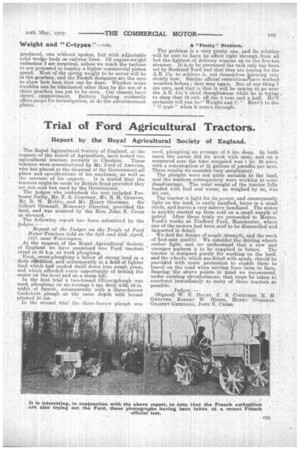Trial of Ford Agricultural Tractors.
Page 11

If you've noticed an error in this article please click here to report it so we can fix it.
Report by the Royal Agricultural Society of England.
The Royal Agricultural Society of England, at the request of the Board of Agriculture, have tested two agricultural tractors recently in Cheshire. These tractors were manufactured by Mr. Ford of America, who has placed at the disposal of the Government .alt plans and specifications of his machines, as well as the services of his experts. It is stated that the tractors might be made by British firms provided they are not sold but used by the Goverment.
The judges who undertook the test included Professor Dalloy, Mr. F. S. Courtney, Mr. R. M. Greaves, Mr. R. W. Hobbs, and Mr. Henry Overman. Sir Gilbert Greenall,Honorary Director, provided the land, and Was assisted by the Hon. john E. Cross as Steward.
The following report has been submitted by the judges •
Report of the Judges on the Trials vf Ford Motor Tractors held on the 24th and 25th, April, 1917, near Warrington.
At the request of the Royal Agricultural Society of England we have examined two Ford tractors rated at 25 h.p. at work ploughing. Firsts cross-ploughing .a fallow of strong land in a dirty ediklition, and subsequently in a field of lighter land which had seeded itself down into rough grass, and which afforded every opportunity of testing the motor on the level and on a steep hill. In the first trial a two-breast Oliverolosugh was used, ploughing on an average 5 ins, deep with 1e-in. width of furrow, subsequently with a throe-furrow Cockshutt plough at the same depth with breast pitched 10 ins.
In the second trial the three-furrow plough was used, ploughing an average of 6 ins. deep. In both cases the motor did its work with ease, and on a measured acre the time occupied was 1 hr. 30 mins. with a consumption of Vs. gallons of paraffin per acre. These results we consider very satisfactory.
The ploughs were not quite suitable to the land, and the tractors consequently were working at some disadvantage. The total weight of the tractor fully loaded with fuel and water, as weighed by us, was 23* cwt.
The tractor is light for its power, and consequently light on the land, is easily handled, turns in a small circle, and leaves a very narrow headland. The motor is quickly started up from cold on a. small supply of petrol. After these trials we proceeded to Messrs. . Ford's works at Trafford Park, Manchester, where one of the motors had been sent to be dismantled and inspected in detail. We lind the design of ample strength, and t•he work of first-rate quality. We consider the driving wheels rather light, and we understand that a new and stronger pattern is to be supplied in future. The tractor is designed purely for working on the land, and the wheels, which are fitted with spuds, should be provided with some protection to enable them to travel on the road when moving from farm to farm. Bearing the above points in mind we recommend, under existing circumstances, that steps be taken to construct immediately as many of these tractors as possible.
Judges :
(Signed) W. E. DAIRY,. F. S. COURTNEY, R. M. GREAVES, ROBERT W. HOBBS,. HENRY OVERM A.N, GILBERT GREEN/UT,. JOIEN E. CROSS.






















